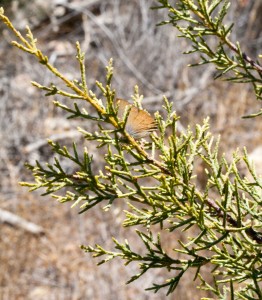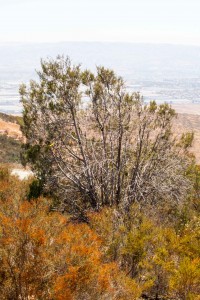Working to Pull a Rare Cypress Back from the Brink of Extinction
Posted in Interesting Plant Stories on January 16, 2015 by Damon Little
Damon P. Little, Ph.D., is Assistant Curator of Bioinformatics in The Lewis B. and Dorothy Cullman Program for Molecular Systematics. In addition to his research projects involving large sets of plant DNA data, he studies the cypress family of conifers.

Last year, I was among a group of land managers and scientists that the Nature Conservancy brought to San Diego to plan for the future of a species that is on the brink of extinction.
Forbes’ cypress (Callitropsis forbesii) has never been particularly common as far as we know. Also known as Tecate cypress, this multi-trunked conifer was first brought to the attention of scientists when it was discovered by a University of California (Berkeley) undergraduate, C. N. Forbes, while hiking near San Diego during his winter break in 1907. Forbes found a single population with only a few scattered trees, but subsequent botanical exploration has turned up a few more populations in southern California and northern Baja California.
By far the largest and most impressive population of Forbes’ cypress covers the upper reaches of Otay Mountain, just east of San Diego and north of the U.S.–Mexico border. In their prime, vast numbers of Forbes’ cypress outcompeted almost all other trees on the mountain, creating a lush, closed canopy of dusky green. That canopy lowered the temperature and increased moisture levels on the forest floor, providing habitat for many other species of plants and animals. Most important, it provided food and shelter for Thorne’s hairstreak, an endangered butterfly that relies on Forbes’ cypress.
In 2007, the Harris wildfire burned much of Otay Mountain. The fire burned hot enough to shatter rocks. Most of the Forbes’ cypresses were killed, but amazingly a few were able to resprout from their charred trunks. The fire released seeds that had been safely sequestered in cones, and soon a carpet of Forbes’ cypress was growing. Despite this fragile recovery, the population on Otay Mountain is just a shadow of its former self. Another fire would most likely completely destroy it.

At the meeting organized by the Nature Conservancy in June, we pooled our knowledge about the current and future climate of southern California, the tree’s reproductive biology, and the survival rates of seedlings. My contribution to the meeting was the biology of Forbes’ cypress: its life cycle, morphology, ecological preferences, and so on.
We considered how and where to replant Forbes’ cypress, the number of seeds and seedlings that will be needed, ways to provide water for the young trees to establish themselves, and measures that will reduce the likelihood of future fires. A seed orchard of 500 trees has already been established on former agricultural land near Otay Mountain. Soon seeds will be collected and put into cold storage in preparation for replanting. Ultimately, our goal is to ensure that Forbes’ cypress survives in the wild.

